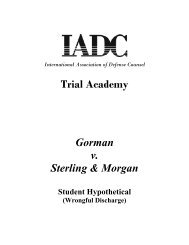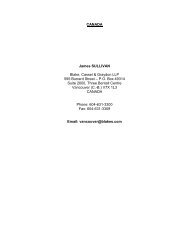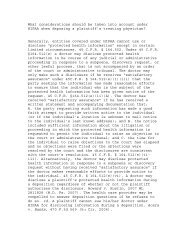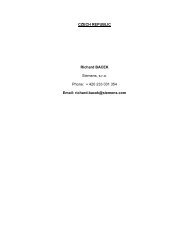Defense Counsel Journal - International Association of Defense ...
Defense Counsel Journal - International Association of Defense ...
Defense Counsel Journal - International Association of Defense ...
You also want an ePaper? Increase the reach of your titles
YUMPU automatically turns print PDFs into web optimized ePapers that Google loves.
Page 458 DEFENSE COUNSEL JOURNAL–October 2012that compensatory and punitive damagesbear a reasonable relationship to oneanother as required by the U.S. SupremeCourt in State Farm v. Campbell. 24 Onecommentator has suggested that “[h]avinga jury set a single, abstract punitivedamage multiplier deprives the jury <strong>of</strong> theopportunity to consider the facts andcircumstances <strong>of</strong> each individualplaintiff’s case and to determine whatamount <strong>of</strong> punitive damages, if any isappropriate for each plaintiff.” 25A small multiplier is less likely to beattacked on the grounds <strong>of</strong> excessivenessor that it lacks a reasonable relationship toactual damages awarded, 26 and thisconcern may also be addressed through acreative trial plan. If all claims areconsolidated for trial, and the punitivedamage multiplier is based on arepresentative group <strong>of</strong> plaintiffs’evidence <strong>of</strong> compensatory damages, amultiplier may be assessed for itsreasonableness based on therepresentative group’s damages following24 State Farm v. Campbell, 538 U.S. 408, 426(2003).25 Sheila N. Birnbaum, Punitive Damages andDue Process: How Much is Too Much,Benjamin N. Cardozo Lecture, THE RECORD,61 No. 2 165, 180 (2006). See also Laura J.Hines, Engle v. R.J. Reynolds Tobacco Co.:Lessons in State Class Actions, PunitiveDamages, and Jury Decision-MakingObstacles to Determining Punitive Damagesin Class Actions, 36 WAKE FOREST L. REV.889, 940 (in the context <strong>of</strong> a mass tort case,where varying facts and state laws may beinvolved, the use <strong>of</strong> a punitive damagemultiplier may not satisfy the reasonablerelationship test, as a multiplier may not beable to measure the true scope <strong>of</strong> harm toabsent class members).26 Hines, supra note 25, at 939-940.that initial trial. Because the multiplier istied to evidence supporting compensatorydamages <strong>of</strong> a representative group <strong>of</strong>plaintiffs, this may address concernsabout the reasonable relationship betweenthe punitive and compensatory awards.Though there is very littlescholarship on the relative merits <strong>of</strong> amultiplier approach in comparison to alump sum award, one scholar has arguedthat the multiplier approach provides amethod <strong>of</strong> assessing punitive damagesthat reflects both the reprehensibility <strong>of</strong> adefendant’s conduct and the varyingdegrees <strong>of</strong> harm that individual plaintiffssuffer. 27 By applying a multiplier toevery dollar <strong>of</strong> compensatory damages,“individuals awarded high amounts <strong>of</strong>compensatory damages will receiveproportionately higher awards <strong>of</strong> punitivedamages.” 28 The author qualifies thisbenefit by stating that proportionality canalso be achieved utilizing a lump summethod that distributes punitive damagesin proportion to the plaintiffs’ harm,rather than on a per capita basis. 29 Also,at least one court has rejected the use <strong>of</strong> amultiplier despite its benefit <strong>of</strong>proportionality, stating that suchtreatment does not “satisfy the state’sinterest in making sure that punitivedamage awards ‘are appropriate inspecific relation to differing amounts <strong>of</strong> –and reasons for – actual damages.’” 3027 Id. at 925.28 Id.; see also Arthur R. Miller and PriceAinsworth, Resolving the Asbestos Personal-Injury Litigation Crisis, 10 REV. LITIG. 419,443-444 (1991) (advocating for a multiplierapproach).29 Id.30 Id. at 931 (citing Phillip Morris, Inc. v.Angeletti, 752 A.2d 200, 249 (Md. 2000)).












